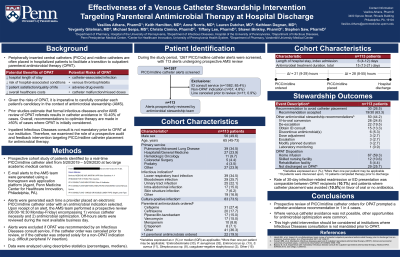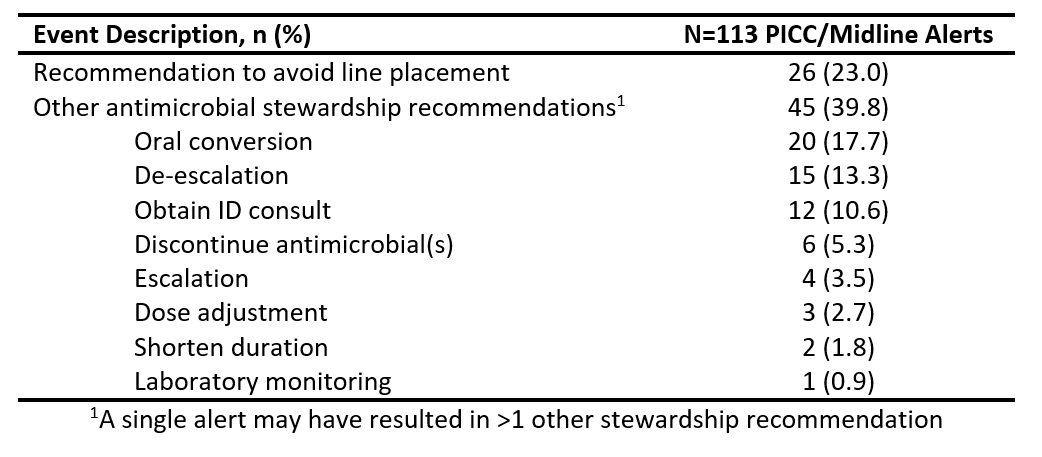Category: Antimicrobial Stewardship: Outcomes Assessment (clinical and economic)
Poster Session: Antimicrobial Stewardship: Outcomes Assessment (clinical and economic)
54 - Effectiveness of a Venous Catheter Stewardship Intervention Targeting Parenteral Antimicrobial Therapy at Hospital Discharge

- VA
Vasilios Athans
Clinical Pharmacy Specialist - Infectious Diseases
Hospital of the University of Pennsylvania
Philadelphia, PennsylvaniaDisclosure: I do not have any relevant financial / non-financial relationships with any proprietary interests.

Keith W. Hamilton
Professor of Clinical Medicine
University of Pennsylvania Perelman School of Medicine
Philadelphia, PADisclosure: I do not have any relevant financial / non-financial relationships with any proprietary interests.
- AN
Anne Norris
Associate Professor of Clinical Medicine
Penn Presbyterian Medical Center
Philadelphia, PennsylvaniaDisclosure: I do not have any relevant financial / non-financial relationships with any proprietary interests.

Lauren Dutcher
Instructor of Medicine
University of Pennsylvania
Philadelphia, PADisclosure: I do not have any relevant financial / non-financial relationships with any proprietary interests.

Kathleen Degnan
Assistant Professor of Clinical Medicine
University of Pennsylvania Perelman School of Medicine
Philadelphia, PennsylvaniaDisclosure: I do not have any relevant financial / non-financial relationships with any proprietary interests.
- YG
Yevgeniy Gitelman
Clinical Informatics Manager
University of Pennsylvania Health System
Philadelphia, PennsylvaniaDisclosure: I do not have any relevant financial / non-financial relationships with any proprietary interests.
- MS
Michael Serpa
Innovation Associate
University of Pennsylvania Health System
Philadelphia, PennsylvaniaDisclosure: I do not have any relevant financial / non-financial relationships with any proprietary interests.
- CC
Christo Cimino
Clinical Pharmacy Specialist
Penn Presbyterian Medical Center
Nashville, TennesseeDisclosure: I do not have any relevant financial / non-financial relationships with any proprietary interests.
- TL
Tiffany Lee
Clinical Pharmacy Specialist - Infectious Diseases
Hospital of the University of Pennsylvania
Philadelphia, PennsylvaniaDisclosure: I do not have any relevant financial / non-financial relationships with any proprietary interests.
- SB
Shawn Binkley
Clinical Pharmacy Specialist - Infectious Diseases
Hospital of the University of Pennsylvania
Philadelphia, PennsylvaniaDisclosure: I do not have any relevant financial / non-financial relationships with any proprietary interests.
- SS
Steve Saw
Clinical Pharmacy Specialist - Infectious Diseases
Hospital of the University of Pennsylvania
Philadelphia, PennsylvaniaDisclosure: I do not have any relevant financial / non-financial relationships with any proprietary interests.
Presenting Author(s)
Co-Author(s)
Background:
Peripherally inserted central catheters (PICCs) and midlines are often used in hospitalized patients who require outpatient parenteral antimicrobial therapy (OPAT) upon discharge. PICCs/midlines offer ease of insertion but still carry the risks of venous thrombosis, phlebitis, and catheter-associated infection. We report the results of a prospective audit and feedback (PAF) intervention targeting the placement of PICCs/midlines for OPAT at our institution.
Methods:
We prospectively identified a cohort of patients identified by a real-time PICC/midline alert from 5/20/2019 through 5/29/2020 at two large academic medical centers. Alerts were generated by a third-party interface with the electronic health record and identified new line orders with an antimicrobial indication selected. Patients without infectious diseases (ID) consult underwent PAF by the antimicrobial stewardship team. Descriptive statistics were used to characterize patients, interventions, and outcomes.
Results:
During the study period, 1267 PICC/midline alerts were identified. Most were excluded due to ID consult (85.4%). After exclusions, 113 alerts underwent full review. Median patient age was 64 years with female predominance (54.2%). Reviewable alerts most commonly originated from Pulmonary (36.5%) and Hospitalist (26.0%) services. The most frequent antimicrobial indications were pneumonia (37.5%) and bloodstream infection (28.1%), and the most frequently ordered antimicrobials were cefepime (27.1%) and piperacillin-tazobactam (17.7%). Median time from line order to insertion was 22 hours and from line insertion to discharge was 48 hours. Of 113 alerts reviewed by the stewardship team, 26 (23.0%) resulted in a recommendation to avoid line placement and 45 (39.8%) resulted in at least one specific stewardship recommendation (Table 1). Recommendations were fully or partially accepted in 58.3% of instances.TABLE 1. Interventions Resulting from Prospective Venous Catheter Stewardship
Conclusion:
Prospective audit of PICC/midline orders for OPAT identified a line-sparing opportunity in nearly 1 in 4 cases. Where line avoidance was not possible, other opportunities for antimicrobial optimization were common. This high-yield intervention should be considered for institutions that do not mandate infectious diseases consult for all OPAT discharges.

